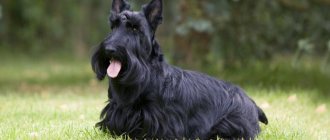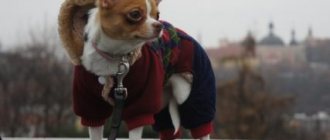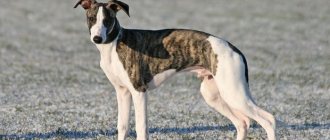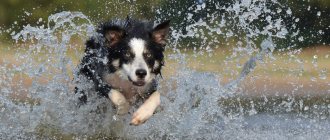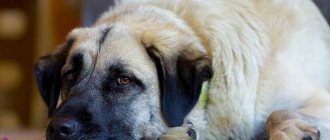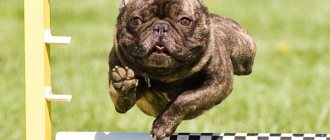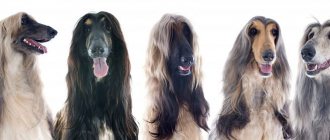As soon as the last warm and dry days of September give way to real autumn, with rain, slush and frost in the mornings, it’s time to change your wardrobe.
Moreover, taking care of yourself will not be a problem - you must not forget about your small pet, who will feel uncomfortable and unwell without warm and comfortable clothes. Therefore, making a clothing pattern for a Yorkshire terrier with your own hands is not just a whim and a desire to dress up someone, but an important condition for healthy and safe care.
Yorkies are delicate and fragile creatures; their own fur provides little protection from cold and dampness.
In specialized stores, of course, ready-made clothes are sold - in bulk assortment for different occasions and at affordable prices.
But each dog is as individual as people, so hand-sewn (knitted) clothes, neatly and lovingly, will fit better in size, made from self-selected hypoallergenic material, taking into account all the characteristics of your four-legged friend.
Well, it is important for any housewife that her ward (ward) is dressed not only practically and functionally, but also beautifully and exclusively.
What you need
To successfully sew, it is enough to have minimal skills; school labor lessons will suffice. A lot of patterns for all styles and needs: from underpants (for girls during heat) to a decorative dress (in which you can even go to a fashionable exhibition) will allow you to create with your own hands any ideal image of a Yorkshire terrier.
Knitting
For knitting, it doesn’t matter too much which tool you use. Mostly, warm thick sweaters, hats and jackets are knitted, and hooks are used to make lighter, summer and spring versions of the same dresses.
With a little practice, you can even move on to boots and shoes with seals on the soles.
Knitted models are truly rare and you won’t find a quality item at a reasonable price in regular pet stores. By adding a little more creative imagination, it is possible to even try something complex and designer for the holiday.
Yorkies are not ordinary dogs; they have rather long hair that rolls off into ugly, sloppy hairs, causing discomfort to the pet.
So for a Yorkshire terrier, you should not use a clothing pattern for a dog of any breed. As a last resort, you need to mark and sew a small indentation for possible friction.
A nice plus is that absolutely any pattern is the same: both for sewing and for knitting with your own hands. This makes it possible to find a significant amount of clothing online, in addition to those described below.
Trying with knitting needles
If you have ever held knitting needles in your hands, then knitting something for a Yorkshire Terrier will not be difficult for you. Clothes knitted with knitting needles will not hold their shape as well as crocheted ones, but they will undoubtedly be warm and will protect the dog from frost. The technique should be chosen depending on your knitting skills.
The best option for beginners would be to knit a cape in the shape of a triangle, which is perfect for a Yorkie. To do this, you only need measurements of the back, and you should start knitting from the tail, adding loops evenly.
Regardless of how the dog product is knitted, the choice of yarn remains the same. It is very important that the yarn is made from natural materials. Otherwise, it may cause discomfort to your pet.
It has also become popular to decorate dog clothes with various decorative elements, which include:
- natural or artificial fur;
- all kinds of sequins or beads;
- beads;
- elements of leather or suede, etc.
Before starting work, you need to take measurements from the dog; knitting by eye will be a very improvident decision. It is better to take measurements from the dog while standing, but it is better to measure the width of the chest when the pet is sitting. But it is worth noting that patterns for Yorkies will differ from patterns for other mini dogs. This is due to the fact that the Yorkshire Terrier's coat tends to mat under tight clothing. Therefore, allowance should be made in places where friction may occur.
Related article: DIY Venetian masks with embroidery: master class with photos
We bring to your attention a master class, using an example of which you can knit a hat for your Yorkie:
- First, you need to take a head circumference measurement and decide how many loops are needed for the product. To do this, knit an example of a part and calculate how many loops there are in 1 centimeter. Based on these calculations, we begin to knit;
- Next, knit 8 rows, alternating knit and purl stitches;
- Then you need to divide the number of loops into 3 equal parts in order to close the rows on the first and third parts and continue to knit only the middle. We knit the middle only with facial loops ;
- As soon as this middle part reaches the mound, start knitting, picking up the loops on each side;
- Thus we continue to knit until the end.
A couple of hours of work, and the hat for your pet is ready!
Taking measurements
The first step in any tailoring, no matter for people or dogs, is taking measurements. Without the exact size, there is no point in starting to fit patterns.
Armed with a measuring tape (preferably with millimeter divisions on the scale - we have to work with a tiny indoor dog) and take the basic measurements, according to which dress patterns for Yorkshire terriers are made, according to the following list:
- the distance between the withers (middle of the neck) and the base of the tail.
- full neck circumference (you need to measure loosely so as not to squeeze your pet’s neck under any circumstances);
- chest circumference (behind the elbows) and waist. Optionally, tail girth;
- belly length from front to back paw (girls and boys will have some differences);
- the length of the paws themselves;
- girths of the muzzle and head (for hats and hoods).
When transferring ready-made patterns to fabric, the first time it is most practical to use old and disused jackets, jeans, T-shirts, sweaters, and other things.
When knitting clothes for a Yorkshire terrier with your own hands according to prepared patterns, some stages can be simplified, because knitted items stretch well and do not need to be carefully adjusted.
Pattern of the base for a Yorkie dog
In this article we will look at constructing a base pattern for dogs (usually for any breed). It will consist of the upper part, i.e. There are no trouser legs, and is suitable for modeling various sweaters and T-shirts. Initial data The drawings are carried out on graph paper and pencil to make it easier to remove incorrectly constructed lines in the drawing and not get confused in them. Let us pay attention to the following point: there are two measurements: Chest girth and Abdominal girth. When creating a pattern for a dog, the larger of these measurements is used, and it is this, the selected measurement, that we will take as the measurement of Chest circumference. This is due to the different builds and fatness of dogs.Measure
| Meaning | |
| Bust | — |
| Length from neck to waist | — |
| Distance between hind and front paws | — |
| Chest circumference | — |
| Back width | — |
| Chest height | — |
| Distance from armpits to reproductive organ | — |
| Length from collar to reproductive organ (or waist) | — |
| Chest Width | — |
| Width between front paws | — |
| Waist circumference | — |
So let's get started. The construction of a joint part is the basis for the pattern of the belly and back (1). In the upper left corner we put t.A. From it to the right we put the measurement Length from neck to waist and put t.V. From T. And also to the right we put aside the measure The distance between the hind and front paws, put T. N. Through the obtained points we draw vertical lines down.
(2). On them from t.A down we put a segment equal to ½ of the chest circumference + 1.5 cm , put t.D. From point B downwards we put aside the measurement ½ of the width of the back + 0.5 cm . In this case, 1.5 cm and 0.5 cm is an increase in freedom of fit . We get t.S. On the line BC from t.B downwards we put 6 cm , put t.K. From t.H downwards we lay off a segment equal to segment AD , mark t.E. We connect it with t.D.
(3). From the received t.K we set aside 4 cm , put t.L. Using a smooth line or using a pattern, we connect points L and B - we get a goal line.
(4). From t.D to the right we set aside the measurement Chest Height + Distance from the armpits to the genital organ or a single measure Length from the collar to the genital organ (or to the waist - for girls), set t.F. From it to the left we put 4.5 cm or 5.0 cm and put t.G. From the resulting t.G upward, we lay a segment equal to ½ of the chest width + 0.5 cm and mark the point J.
(5). From t.F 3 cm up , put t.F1. From it to the right we set aside 1 cm and put t.I. J and I with a straight line I and F with a smooth line or using a pattern .
(6). Next, from t.G up vertically we lay off a segment equal to ½ the Width between the front paws , put t.M. From it to the left we draw a segment until it intersects with the NOT and put t.M1 . After this, divide MM1 t.R.
(7). Similarly, we divide the segment KL into two and set t.P. Draw a vertical line down from it and place point O so that the segment LO is the same as the segment JI .
(8). From point C to the right and left we lay horizontal lines until they intersect with the segments PO and NOT . At the intersection points we mark points C1 and C2 , respectively. the resulting segment C1C2 by two and set t.V.
(9). T.N is the midpoint of the segment C2M1 . As a result of construction, we get an armhole line - a smooth line connecting points O, V, N, R, J.
(10). We complete the construction as follows. From t.N to the left we draw a line until it intersects with the segment AD , put t.S. From it up and down we set aside segments equal to ¼ (chest circumference - waist circumference ). We denote the points T and Q. We connect them with straight lines to point N.
(11). Congratulations! Now you have the basic foundation for a dog. Let us remind you once again about the importance of maintaining right angles in the places where the pattern is folded (conjugating corners).
Vadiy.
blanket
The simplest clothing for a dog with your own hands is a blanket that protects the back and sides from strong winds and frost. It would be practical to leave some space and sew on Velcro or fasteners for an insulated removable lining (this will turn the blanket into a demi-season option).
To make it, it is enough to know the results of measurements of the back length and neck circumference. There are two options: a blanket made of two parts (sew along the measurement line, leaving a little free space for the seam), a blanket made from a single piece of fabric (in this case, the fold lines and the size coincide). At the withers, the back is sewn with a collar equal to the circumference of the neck.
A belt in the shape of the letter T, sewn to the lower edge of the collar, will hold the clothes on the pet; for a more reliable fixation, you can sew a smaller collar for the tail (you will need to additionally measure there too).
Knitted option
The knitted version of the blanket with your own hands has several features. You should start with a circular collar, 2-3 loops in each centimeter. Having finished the required length, you need to close about a third.
The back is knitted in the manner of a canvas, adding one loop every other row until the width is 6 cm. Then the yarn overs are stopped and the piece is finished off with simple knitting.
T-shirt
More like decorative clothing for a four-legged animal, the lightweight T-shirt has a very simple sewing pattern and is suitable for training before more serious tasks. The easiest option for a Yorkshire Terrier pattern is to alter a children's T-shirt.
Having cut on both sides according to the size of the chest circumference (taking into account the processing of the seams), the T-shirt is sewn to the new parameters on the sides, altering the collar if necessary. In this style, there will be sleeves only for the front legs. The finished product can be easily decorated with rhinestones, sequins and similar elements.
How to sew clothes for a Yorkie with your own hands: description and pattern
Any dog, regardless of age and breed, requires care and self-care. Your Yorkshire Terrier puppy and adult will thank you for clothes that will make him feel warm and cozy. In this article we will tell you how to quickly and easily sew a warm blanket for a Yorkie (for rainy weather, a fur coat for cold winters), as well as a demi-season vest. Creating such clothes will not require much expense or time from you.
The blanket pattern we offer is designed for sizes twenty-four to twenty-five centimeters (the length of the back from the beginning of the neck to the tail). Our pattern already includes seam allowances. When you change the size, be sure to take into account the volume of the dog's neck, its width and length.
For work you will need : fifty centimeters of lining material (if you intend to sew a warm blanket);
bias tape (one and a half meters);
Velcro fastener (twenty centimeters).
Description of work
It is necessary to cut out three parts. Then grind the bend of the “visor” using tape (part number three).
When turning the remaining parts using tape, at the same time it is necessary to attach a visor under the tape with the front part of part number one.
On element number one, you need to stitch the strap on the right with part number two in this way: fold the parts in an “overlapping” manner one on top of another (face and back), and it is important to take into account that the elements are at an angle of ninety degrees in relation to one another.
Next, you need to attach Velcro fasteners in certain places of parts number one and number two, first basting them on the fabric in order to achieve maximum matching of the 2 elements.
Using the proposed pattern , you can create both a raincoat from raincoat fabric and a warm blanket. In the second case, you will need to attach a lining to the top of all parts (except for the visor). It can be fleece or any other insulating material.
Two-sided blankets look even more original. In this case, you will only need to use two different, but high-quality materials, which will look like the front side, depending on what kind of clothes you will sew for your Yorkie. Using a Velcro fastener will allow you to wrap its edges in the direction you see fit.
Using this pattern, you can sew a warm fur coat from natural or faux fur. If you choose artificial material for sewing, the edges of the fur coat can be finished using a zig-zag seam. This will close the long fur. In order to stitch the edges of a fur coat made of artificial material on a regular sewing machine, it is necessary to remove the lint from the surface being treated, retreating half a centimeter from the edges. In those places where you plan to sew Velcro, the pile also needs to be cut off.
When using natural fur, the edges do not need to be stitched. A blanket that has a fur trim along the edge will look very impressive.
The next product that we suggest you sew is a vest . You can create it from old jeans. Such a product will look very impressive, no worse than branded clothing from specialized stores.
To create a pattern, we will need measurements of the neck and chest circumference. Having printed out the proposed pattern, it will one hundred percent correspond to the following measurements of your pet: thirty-three centimeters - chest circumference, twenty-five centimeters - neck circumference.
To sew a vest for a Yorkie, we will need: twenty-five centimeters of the material you like, twenty-five centimeters of flannel, a metal half-ring (diameter is three and a half centimeters); braid for creating an edging (one and a half meters) or bias tape; Velcro fastener; ribbon for bags (length - twenty centimeters, width - three and a half centimeters under the half ring).
Description of work
We create a material pattern without seam allowances (cut one piece from flannel material) and one piece from the main fabric, taking into account seam allowances. Then you need to sew them together, and then carefully remove the excess fabric along the edge of the flannel part. Next, create a border using tape from point No. 1 to point No. 2. Then we need to sew on the bag ribbon and thread the half ring, then attach the ribbon completely. Wide Velcro will be used as a fastener.
That's all! Your Yorkie vest-harness is ready . It will be useful for little puppies who are just going for their first walk. Using such a harness will allow your pet to freely stretch its neck while walking without choking. The product, if desired, can be decorated with rhinestones, bows or embroidery.
Vest
Practical against dirt, bad weather and cold, easy to sew with your own hands and does not impede the movements of the Yorkie. The most affordable option is a single piece of fabric on the stomach, fastened at the back. You will need measurements of the chest circumference at the widest point (immediately behind the elbows) and the length of the back. To create a lining, you will need to re-create a denser lining.
All pattern pieces are overlocked along the edges and sewn so that the elements of the back and tummy match. If desired, the design can be modernized with sleeves for the front paws, an elastic band can be sewn into the base, a small knitted collar can be cut out, a hood with an elastic band - there are a lot of modifications, if you have the skills and desire to create a varied, colorful and multifunctional wardrobe for the dog.
Working with a sleeve
So, when all the materials are in place, the first thing you need to do is take the scissors and then cut the sleeve off the sweater, moving exactly along the shoulder seam. Then you can tear the old jacket into rags, make a vest out of it by cutting off the second sleeve, or simply throw it in the trash, and further work will be done only with the cut-off part.
Ceremonial artifacts at least 1,500 years old found in Bolivia (photo)
4 Zodiac Signs Stay Calm Even When Things Go awry
Teledoctor Myasnikov believes that Covid is not as dangerous as obesity
Next, we call the dog and put the sleeve on top of its back, turning the cuff to determine its size and mark with a marker two points where you will need to make holes for the dog’s two front paws.
The main thing is to take into account that they should be located opposite each other on the side of the sleeve where its seam goes, because when the clothes are put on the dog, it will run along its stomach. After this, the pet can be sent about its doggy business and start working with scissors again.
After all, now you need to cut off the cuff on the sleeve, which would severely compress the animal’s neck. You should also use scissors to make cuts in the places where you will need to insert the dog’s paws.
Astronomers have confirmed the existence of a planet with three suns
A woman picked up a crying baby on the street and brought him to a new cat family
A man ferried a deer across the river in a quick way (video)
Sweater
For such an indoor baby, there is a simple and elegant solution to the preparation - take a ready-made sleeve for a large sweater.
Moreover, even a warm sock is enough to protect a Yorkshire Terrier puppy from the cold. It is important to ensure that the wool has hypoallergenic properties. In the diagram you should add about 5 cm to the length of the back.
The most difficult thing here is with the sleeves: you need to select the exact location and cut out two holes, which you immediately need to go over with an overlocker - the threads unravel easily and quickly.
The two small tubes themselves, along the length of the paws, are beautifully cut from the remnants of the same sweater and are also carefully sewn along the edges - a little prankster can fray the hem of the sleeves, and in general they constantly need to be in contact with the surface.
If the neckline seems too narrow or, on the contrary, wide, it will not be a problem to loosen it slightly and sew in an elastic band.
Overalls
Fastened with a zipper, this item of clothing is a must-have in a terrier's wardrobe. All kinds of dresses can still be sacrificed, but overalls in winter save you from the cold and wet, dirty snow, saturated with caustic salt and other chemicals (in the city).
Spring and autumn need no introduction – every dog strives to collect all the dirt within its reach. Even in summer, in order not to bring back a tick from a walk, comfortably nestled on its tender abdomen, you will need an appropriate lightweight version.

